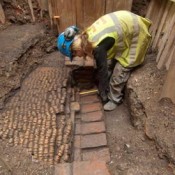The find, described as “once-in-a-lifetime” piece, is made of gold and gemstone and dates back to 630-670 AD.
It was found within a grave near Northampton by archaeologists from the Museum of London Archaeology (MOLA). The team was conducting excavations prior to a housing development project in Harpole.
Thirty pendants and beads made from Roman coins, gold and semi-precious stones make up the jewelry. Its centerpiece is a rectangular pendant with a cross motif made of red garnets set in gold.
Two decorated pots and a shallow copper dish were also among the grave goods.
The grave offerings turned out to be part of a female bed burial. The deceased was apparently a high-status individual. During the Saxon period this type of burials was reserved only for elite class women. The skeleton has long since disintegrated with the exception of tiny tooth enamel fragments.
X-rays taken on a block of soil revealed an elaborately decorated cross featuring unique depictions of oval human faces cast in silver with blue glass eyes.
“This find is truly a once-in-a-lifetime discovery – the sort of thing you read about in textbooks and not something you expect to see coming out of the ground in front of you”, Simon Mortimer, RPS Archaeology Consultant, said.
“The Harpole Treasure,” said Lyn Blackmore, a senior finds specialist at MOLA, “it’s not the richest (bed burial) in terms of the number of artifacts but it is the richest in terms of investment of wealth … and it has the highest amount of gold and religious symbolism,” she said at a news briefing.”





